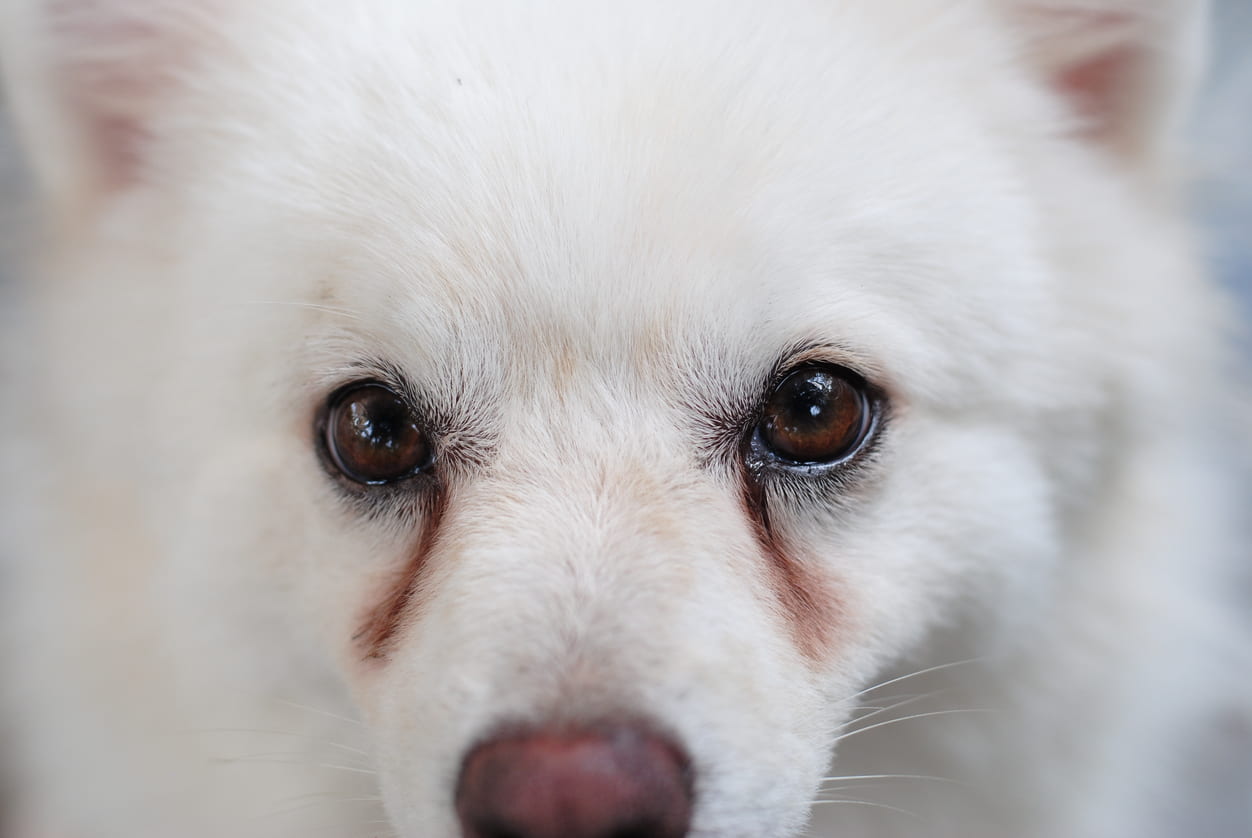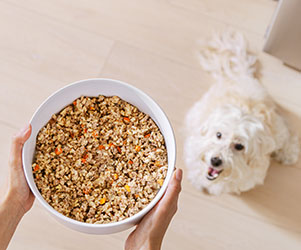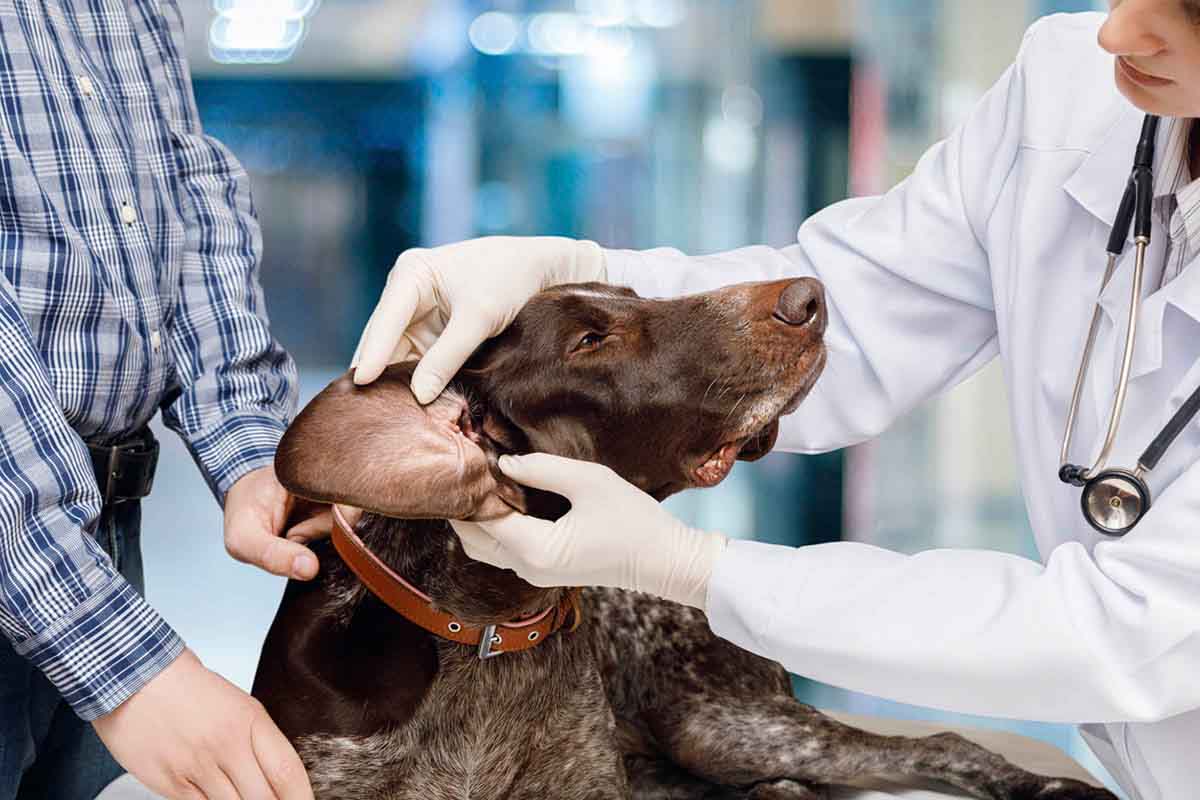How to Help Improve Dog Tear Stains Naturally
Tear stains on your dog’s face can be unpleasant and uncomfortable. Here’s everything you need to know about the causes of tear stains, what they might mean for your dog’s health, and how to potentially remove dog tear stains naturally at home.
Tear stains on your dog’s face can be unpleasant and uncomfortable. Here’s everything you need to know about the causes of tear stains, what they might mean for your dog’s health, and how to potentially remove dog tear stains naturally at home.
What Are Dog Tear Stains?
Dog tear stains are reddish-brown marks around a dog’s eyes and face caused by eye discharge (or tears). They’re typically more prominent in white dogs or light colored dogs, but they can also be seen in the facial hair of dogs with darker coats. Tear stains in dogs are often harmless, but can sometimes be an indicator of underlying health problems.
Why Do Dogs Get Tear Stains?
When dogs produce tears, they don’t typically run down their faces like when humans cry. A dog’s tears usually drain internally from the eyes to the nose through something called the nasolacrimal duct.
Dog tear stains are caused when their tears don’t all drain through this passage, and instead drain from their eye down their face. Tear stains on a dog don’t necessarily mean excessive tearing, but rather that their tears aren’t draining properly.
Are Dog Tear Stains a Problem?
For many dogs tear stains are completely harmless. They can be caused by something as simple as the shape of a dog’s eye, but can sometimes indicate an underlying health issue. If your dog has always had tear stains then they likely aren’t something to worry about. If you notice your pup developing them or existing tear stains worsening, talk to your veterinarian.
Causes of Tear Stains in Dogs

Dog tear stains can be caused by anything from blocked tear ducts to puppy teething, or simply the shape of a dog’s eye. While they don’t always indicate a problem, it’s important to understand the possible causes to rule issues out.
Allergies
Dogs can have allergies just like humans! Common dog allergies include reactions to certain foods or their environment like seasonal allergies. Reactions to both types of allergies can make dogs itchy around their mouth, eyes, ears, and paws, and can also cause excessive tear production.
Common Dog Food Allergies
- Beef
- Chicken
- Dairy
- Eggs
- Soy
- Wheat
Common Dog Environmental Allergies
- Dust mites
- Flea bites
- Mold
- Mildew
- Pollen
- Ragweed
To help manage your dog’s allergies, consider adding an allergy supplement to their diet. Allergy soft chews for dogs are made up of natural ingredients that support pets with seasonal allergies and help maintain healthy immune function.
Eye Infections
Sometimes dog tear stains can indicate an infection in their eye. Common eye infections in dogs include conjunctivitis and yeast infections. New or worsening eye stains on your furry friend’s face, itching, or discharge from the eyes can all be indicators of one of these infections, especially if you notice an unpleasant smell.
Blocked Tear Ducts
When a dog’s nasolacrimal duct is blocked or obstructed, their tears can’t naturally drain from their eye sockets like they’re supposed to. The build-up of tears need somewhere to go and can discolor your dog’s fur as they run down your dog’s face, leaving what we know as tear stains around your dog’s eye.
Teething
Dog tear stains can sometimes be caused by a simple thing like teething! When puppies are developing their adult teeth, they produce a lot more tears. This is usually caused by swelling of the gums as their teeth are growing, and their eyes tend to water quite a bit — sometimes leading to tear stains.
Genetics
Some dog breeds are more likely to develop tear stains than others simply due to their genetics. This is mainly due to selective breeding, which has favored short noses and big eyes that can lead to abnormalities in the shape of a dog’s eye socket or tear ducts. It’s important to remember that while sometimes unsightly, for most dogs tear stains aren’t a problem at all.
Dog Breeds Most Likely to Develop Tear Stains
- Bulldogs
- Boxers
- Pekingese
- Pugs
- Terriers
- Shih Tzus
- Maltese
- Poodles
- Cocker Spaniels
- Schnauzers
- Dachshunds
- Bichons
- Golden Retrievers
Drinking Water
Tap water can sometimes be high in minerals like magnesium and iron that can cause discoloration and tear stains in dogs. This can be especially true in areas that rely on well water. Pet owners who live in areas that do so should consider giving their pets filtered water or distilled water only.
Diet
Your dog’s diet can also be a factor in whether or not they develop tear stains. Dogs who eat a lot of red meat are sometimes more prone to red or brown discoloration around the eyes. Dog diets that contain large amounts of fillers, dyes, and preservatives can also contribute to tear stains. Making sure your dog’s diet is full of high-quality ingredients is a great way to help avoid dog tear stains.
Glaucoma
Tear stains in dogs can sometimes be caused by medical conditions like glaucoma, a degenerative eye disease caused by damage to the optic nerve. Dogs who have glaucoma may experience pain in their eye area, red in the whites of their eyes, and watery discharge from the eyes which can contribute to tear stains.
How To Get Rid Of Tear Stains on Dogs
Getting rid of tear stains on dogs isn’t usually necessary, but removing them can help your pup look more like themselves and do away with pesky marks.
Keep in mind that some of these methods are not guaranteed to work on all dogs. As always, consult a veterinarian before attempting any of them.
Natural Dog Tear Stain Removers and Home Remedies
Even tear stains that are harmless can be unsightly. For dog owners who want to remove these pesky imperfections, these are the natural methods you can use at home to remove those little brown blemishes from your sweet pup’s face.
Apple Cider Vinegar
Adding a teaspoon of apple cider vinegar (you can also use distilled white vinegar) to your dog’s water can help with tear stains by increasing the acidity of your dog’s natural pH levels. This not only helps prevent unsightly tear stains, but apple cider vinegar can also help balance your dog’s natural alkaline to prevent bacteria and infections.
Lemon Juice
Using lemon juice to help prevent dog tear stains from developing works similarly to vinegar. The acidity of the lemon added to your dog’s water helps to balance the natural pH and alkaline levels, avoiding conditions that can cause tear stains in the first place.
Hydrogen Peroxide
Mix one tablespoon of hydrogen peroxide in an eight-ounce glass of water and use a cotton ball dipped in the solution to gently clean around the stained area, being careful not to make contact with your dog’s eyes. Using a cloth, wipe your dog’s face with warm water after using hydrogen peroxide. Hydrogen peroxide should be used with extreme caution and only in dilute form. Direct contact with the eyes can cause severe irritation.
This content is for informational use only and does not replace professional nutrition and/or medical advice, diagnosis, or treatment. It is not a substitute for and should not be relied upon for specific nutrition and/or medical recommendations. Please talk with your veterinarian about any questions or concerns.
Citations
“Veterinarian Cautions against Using Unnecessary Over-The-Counter Drugs | Kansas State University | News and Communications Services.” n.d. Www.k-State.edu. Accessed July 25, 2024. https://www.k-state.edu/media/newsreleases/oct14/tearstains102114.html.








